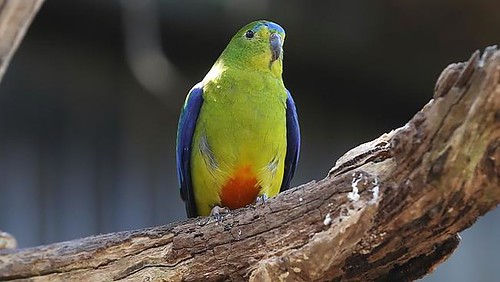Disease puts rare migratory parrot on verge of extinction
 Monday, June 1, 2015 at 2:38
Monday, June 1, 2015 at 2:38  The critically endangered orange-bellied parrot. Picture: Hamish BlairThe last wild population of an Australian parrot on the brink of extinction has been hit with a potentially deadly disease, leading to a disastrous breeding season and fears the orange-bellied parrots’ annual migration from Tasmania to Victoria and South Australia this winter could be its last.
The critically endangered orange-bellied parrot. Picture: Hamish BlairThe last wild population of an Australian parrot on the brink of extinction has been hit with a potentially deadly disease, leading to a disastrous breeding season and fears the orange-bellied parrots’ annual migration from Tasmania to Victoria and South Australia this winter could be its last.
The Threatened Species Commissioner, Gregory Andrews, confirmed yesterday that he had been briefed on an outbreak of beak and feather disease in the only wild population of orangebellied parrots, already categorised as being on the brink of extinction and ranked as one of the world’s rarest and most endangered species.
Its wild population is believed to be as few as 50 birds, with a further 345 in a captive breeding
program. Mr Andrews said news of the disease was extremely worrying but it was not time to give up on the orange-bellied parrot, an amazing bird that he said deserved more science.
“Each year they fly across Bass Strait to their coastal feeding plains … you wouldn’t think they were strong enough — they are little Aussie battlers,” he said. The green, orange and blue
birds — one of only three migratory parrot species in the world — have been cited in arguments against a raft of developments, including by the Howard government when it vetoed a Victorian wind farm for the parrots’ sake. The birds were then central to extreme caution and hold-ups over a Mornington Peninsula marina expansion and they have become a fixture in the debate over Tasmania’s forests.
The outlook for the parrot was so grim in 2011 that most hatchlings were taken into captivity.
Now 18 scientists and researchers who make up the orange-bellied parrot recovery team will hold an emergency meeting on how to respond to the latest crisis.
At least 35 parrots returned to the breeding site at Melaleuca, in the Tasmanian Wilderness World Heritage Area for last summer’s breeding season, a slight increase on previous years.
While 30 young were sighted, it is understood that only about 10 made it to fledglings. Mr Andrews said the beak and feather disease was thought to be a significant part of the reason. It is a relatively common disease among birds, but a huge threat to the orangebellied parrot because its numbers are already so low.
“Despite the very best efforts of the non-government sector and the Tasmanian government and organisations on the mainland, this year’s breeding was disappointing,” he said.
Mr Andrews said the discovery of the disease among the orangebellied parrot population may in
fact be a breakthrough. He hoped the federal government’s $30 million National Environmental Science Program could be used to boost efforts to save the parrot. “We must not get scared and start to think about other options — the bird still deserves a fair go,” he said.

